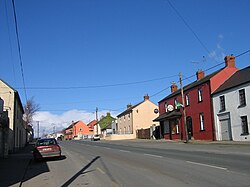Difference between revisions of "Ballyroan, County Laois"
(Created page with "{{Infobox town |name=Ballyroan |irish=Baile Átha an Róine |county=Laois |picture=IMG Main street Ballyroan5150w.jpg |picture caption=Ballyroan's main street |os grid ref=S46...") |
|||
| Line 11: | Line 11: | ||
|census year=2016 | |census year=2016 | ||
|LG district=County Laois | |LG district=County Laois | ||
| + | |post town=Portlaoise | ||
| + | |postcode=R32 | ||
|townland=yes | |townland=yes | ||
}} | }} | ||
| − | '''Ballyroan''' is a small town in [[ | + | '''Ballyroan''' is a small town and civil parish in the barony of [[Cullenagh]] in [[County Laois]]. The R425 regional road passes through the village. |
==History== | ==History== | ||
Ballyroan is an ancient settlement, though its origins are obscure. A castle likely stood there in the Middle Ages, as one Conall Ó Mórdha, son of Daibhí Ó Mórdha, lord of Laois, is attested to have "built the castle of Baile atha in roine" in the fourteenth century.<ref>{{cite book |last1=O'Conor |first1=Thomas |title=Ordnance Survey Letters: Queen's County |date=1838 |page=260 |url=http://www.askaboutireland.ie/reading-room/digital-book-collection/digital-books-by-subject/ordnance-survey-of-irelan/ |access-date=4 June 2019}}</ref> The area remained in the hands of the O'Mores until the sixteenth century; it is listed in the possessions of Conall Ó Mórdha (d. 1537). | Ballyroan is an ancient settlement, though its origins are obscure. A castle likely stood there in the Middle Ages, as one Conall Ó Mórdha, son of Daibhí Ó Mórdha, lord of Laois, is attested to have "built the castle of Baile atha in roine" in the fourteenth century.<ref>{{cite book |last1=O'Conor |first1=Thomas |title=Ordnance Survey Letters: Queen's County |date=1838 |page=260 |url=http://www.askaboutireland.ie/reading-room/digital-book-collection/digital-books-by-subject/ordnance-survey-of-irelan/ |access-date=4 June 2019}}</ref> The area remained in the hands of the O'Mores until the sixteenth century; it is listed in the possessions of Conall Ó Mórdha (d. 1537). | ||
| − | In 1686, Alderman John Preston | + | In 1686, Alderman John Preston founded a private school in the village known as Ballyroan School, endowed with lands in [[Cappaloughlan]]. The school was in a large, slated building erected at a cost of £500, which has since been demolished. Protestant boys received a free education, while Roman Catholic boys paid £1 per quarter. In the nineteenth century, the school moved to Abbeyleix. In 1877 the Brigidine Sisters came to the village and opened a Roman Catholic school. Three nuns from the Abbeyleix Community took up residence in their newly built convent on 25 September of that year. Their convent and school closed in 1974. |
In 1831, Ballyroan had a population of 714. In 1841, on the eve of the Great Famine, it had a population of 637. The size of the village has since declined considerably. In 1996, the population was 173; in 2002, it was 142.<ref>{{Cite web|url=https://www.cso.ie/en/media/csoie/census/documents/vol1_t5.pdf|title=Volume 1, Population.|website=Central Statistics Office}}</ref> | In 1831, Ballyroan had a population of 714. In 1841, on the eve of the Great Famine, it had a population of 637. The size of the village has since declined considerably. In 1996, the population was 173; in 2002, it was 142.<ref>{{Cite web|url=https://www.cso.ie/en/media/csoie/census/documents/vol1_t5.pdf|title=Volume 1, Population.|website=Central Statistics Office}}</ref> | ||
Latest revision as of 08:04, 28 May 2021
| Ballyroan Irish: Baile Átha an Róine | |
| County Laois | |
|---|---|
 Ballyroan's main street | |
| Location | |
| Grid reference: | S464889 |
| Location: | 52°56’52"N, 7°18’19"W |
| Data | |
| Population: | 563 (2016) |
| Post town: | Portlaoise |
| Postcode: | R32 |
| Local Government | |
| Council: | County Laois |
Ballyroan is a small town and civil parish in the barony of Cullenagh in County Laois. The R425 regional road passes through the village.
History
Ballyroan is an ancient settlement, though its origins are obscure. A castle likely stood there in the Middle Ages, as one Conall Ó Mórdha, son of Daibhí Ó Mórdha, lord of Laois, is attested to have "built the castle of Baile atha in roine" in the fourteenth century.[1] The area remained in the hands of the O'Mores until the sixteenth century; it is listed in the possessions of Conall Ó Mórdha (d. 1537).
In 1686, Alderman John Preston founded a private school in the village known as Ballyroan School, endowed with lands in Cappaloughlan. The school was in a large, slated building erected at a cost of £500, which has since been demolished. Protestant boys received a free education, while Roman Catholic boys paid £1 per quarter. In the nineteenth century, the school moved to Abbeyleix. In 1877 the Brigidine Sisters came to the village and opened a Roman Catholic school. Three nuns from the Abbeyleix Community took up residence in their newly built convent on 25 September of that year. Their convent and school closed in 1974.
In 1831, Ballyroan had a population of 714. In 1841, on the eve of the Great Famine, it had a population of 637. The size of the village has since declined considerably. In 1996, the population was 173; in 2002, it was 142.[2]
An Irish Volunteer Corps was established in Ballyroan in mid-1914.[3] During the debate as to whether the Irish Volunteers should participate in the First World War, the Ballyroan corps were the only corps in Laois to support Eoin MacNeill, who favoured staying out, over John Redmond, who urged the volunteers to join the war. On 3 April 1920, the abandoned Royal Irish Constabulary police barracks in Ballyroan were attacked and burned.
Sport
- Gaelic football: Ballyroan Abbey GAA
References
- ↑ O'Conor, Thomas (1838). Ordnance Survey Letters: Queen's County. p. 260. http://www.askaboutireland.ie/reading-room/digital-book-collection/digital-books-by-subject/ordnance-survey-of-irelan/. Retrieved 4 June 2019.
- ↑ "Volume 1, Population.". https://www.cso.ie/en/media/csoie/census/documents/vol1_t5.pdf.
- ↑ "Laois 1913-1923" (in en). http://www.gerdooley.com/laois-1913-1923-talk-to-laois-heritage-society-as-part-of-2016-heritage-week.



